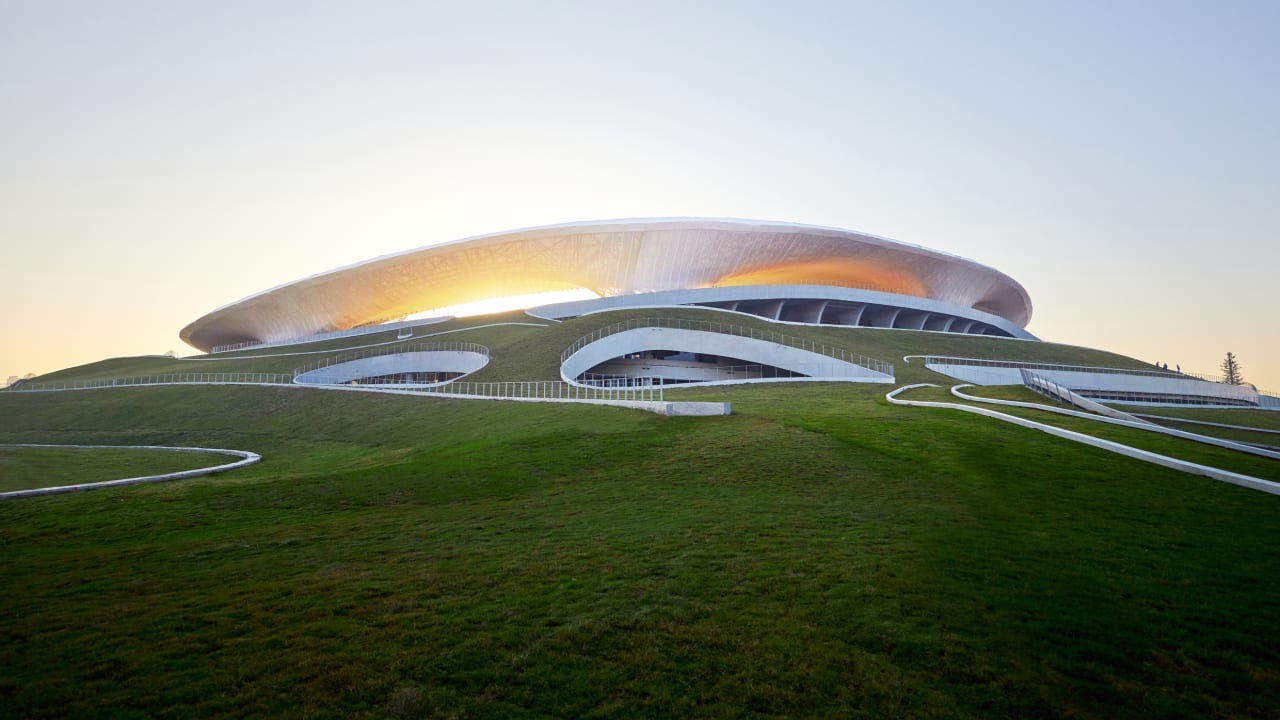| ||||
| ||||
|
- 4:00 AM
This new Chinese sports stadium looks like an alien landscape
“The architecture disappears into nature.”

With 30,000 seats, a red ring of running lanes for track events, and a central soccer field, the new stadium in the eastern Chinese city of Quzhou, is very clearly a place for sports. But for MAD Architects, the Beijing-based firm that designed the stadium to blend into the surrounding landscape like a crater on the moon, the project is actually a massive piece of land art.
“The architecture disappears into nature,” says MAD Architects founder Ma Yansong. Rolling green hills surround the stadium, and other facilities that are still under construction, in what will be a huge, 6.5 million square foot sports park. These kinds of spaces are typically covered with asphalt parking lots and sliced through by transportation infrastructure. Ma says all that hard surface takes away from the human experience of such a space especially one hoping to be a new central public space for a city of more than 2 million. “We covered all this space, including the buildings, with landscape,” he says. “When people come here they will not only use the building, they’ll also use the outdoor space and in between space as a park, as nature.”
![[Image: Aogvision/courtesy MAD Architects]](https://wp-cms-fastcompany-com.s3.amazonaws.com/uploads/2022/10/03-90800212-quzhou-stadium.jpg)
The stadium is the central built part of the park, and it stands out as an otherworldly icon, the crater in an undulating landscape of green grass. A halo-like roof seeming to hover just above the lip of the crater, cantilevering over the seating inside. “We buried all the seating into the landscape, so that’s like part of the ground. And the roof we wanted to be part of the sky, so it’s almost like a floating cloud from far away,” says Ma. Connecting at just nine points around the perimeter of the stadium, the roof structure dips down on one side of the stadium, offering the higher seats on the other end a view of the park’s central lake and the Quzhou skyline in the distance. “Stadiums normally are very focused on the games and indoor functions,” Ma says. “We wanted to make sure that the view is not just towards the inner part of the building, but also connects to the outside.”
![[Image: CreatAR Images/courtesy MAD Architects]](https://wp-cms-fastcompany-com.s3.amazonaws.com/uploads/2022/10/23-90800212-quzhou-stadium.jpg)
The rest of the park is pocked with similarly upraised mounds of grass-covered sports venues, including a gymnastics venue, a basketball stadium and a swimming pool, all still under construction. “We call them volcanoes,” Ma says. “You can climb onto them, you can wander in between the volcanoes. The experience is unique.”
![[Image: CreatAR Images/courtesy MAD Architects]](https://wp-cms-fastcompany-com.s3.amazonaws.com/uploads/2022/10/06-90800212-quzhou-stadium.jpg)
While sporting events are the main draw for this kind of a venue, Ma says his concept for the park was to provide reasons for people to visit regularly, whether there’s an event or not. Conceptualizing the project as a form of land art was a way to create such a draw, he says. It offers what he hopes will be a surreal escape from reality. “Everything in the modern city is too materialized, and too practical. But people are looking for spiritual and emotional space,” Ma says.
![[Image: Arch Exist/courtesy MAD Architects]](https://wp-cms-fastcompany-com.s3.amazonaws.com/uploads/2022/10/10-90800212-quzhou-stadium.jpg)
MAD Architects has become known in China and the U.S. for its fluid forms and ambitious large-scale projects, from the cloud-like Lucas Museum of Narrative Art expected to open in Los Angeles in 2025 to a huge social housing complex in Beijing that fuses public space and urban amenities.
![[Image: Tian Fangfang/courtesy MAD Architects]](https://wp-cms-fastcompany-com.s3.amazonaws.com/uploads/2022/10/13-90800212-quzhou-stadium.jpg)
![[Image: CreatAR Images/courtesy MAD Architects]](https://wp-cms-fastcompany-com.s3.amazonaws.com/uploads/2022/10/22-90800212-quzhou-stadium.jpg)
The firm is well-practiced in designing otherworldly spaces, and subverting expectations. Ma says this is about more than just form making—it’s giving people new avenues for reconnecting with their community and nature. “I think everyone needs such a space to find freedom for the spirit,” he says. “So that’s our goal.”
![[Image: Aogvision/courtesy MAD Architects]](https://wp-cms-fastcompany-com.s3.amazonaws.com/uploads/2022/10/24-90800212-quzhou-stadium.jpg)



No comments:
Post a Comment